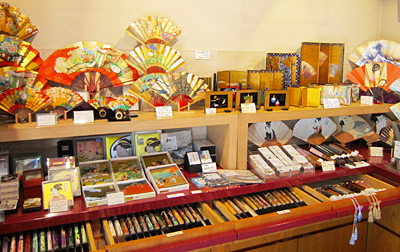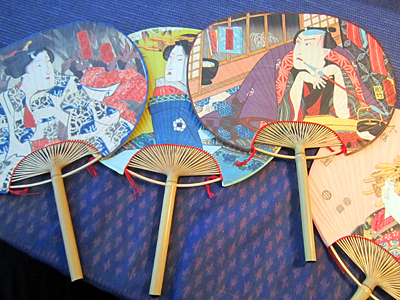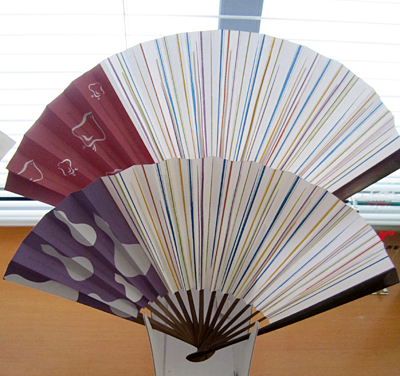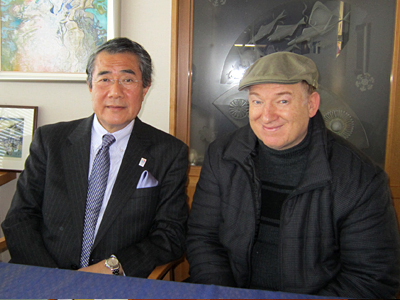 |
セインさん、今日伺うのは日本橋小舟町にある、うちわと扇子の老舗「伊場仙」。
天正18年(1590)創業という、歴史のあるお店です。あとで、ビルの1階にあるお店も、のぞいてみましょう。
Thayne-san, today we’ll be visiting a Japanese hand fan shop called “Ibasen,” in Nihonbashi-Kobunacho. It has a long history, having been founded in the eighteenth year of Tensho (1590)1590. Afterwards, let’s take a look inside the shop on the first floor. |
|
|
 |
はい、楽しみです。エレベーターに向かう通路に造られているギャラリーもいい雰囲気ですね。今日は立派な雛人形が飾られていて、きれいですね。
I’m looking forward to it. This The little gallery in the hallway to the elevator looks wonderful. The Hina-ningyo dolls on display for the Doll’s Festival are beautiful. |
|
|
 |
古い商家は、こういう工芸品や美術品をたくさん持っていらっしゃるんです。
Old merchants often have lots of handicrafts and other works of art like these. |
|
|
|
 |
|
|
| (吉田) |
ようこそ、セインさん、コンシェルジュさん。伊場仙の吉田誠男です。
Hello, Thayne-san, thanks for coming. I’m Yoshida Masao of Ibasen. |
|
|
 |
こんにちは、吉田さん、はじめまして。
伊場仙さんは東都のれん会のなかでもとくに歴史のあるお店だそうですが、吉田さんで何代目になるんですか?
Hi, Yoshida-san, it’s great to meet you. Even among the Toto Norenkai member shops I hear yours has an extra-special history. Tell me, what generation owner are you? |
|
|
| (吉田) |
14代目です。
The I’m the fourteenth14th. |
|
|
 |
14代、親から子へと、お店と技を伝えてこられたんですね。
Wow, So all the knowledge and skills for your work have been passed down from father to son for fourteen 14 generations? |
|
|
| (吉田) |
いえ、必ずしも親から子へ、というわけでもないんです。養子をもらった代もあります。安政の地震の時には、後継者が亡くなるというアクシデントもありましたし、子どもがいても、もっとよい人材がいるというので、遠い親戚に来てもらったり……。長く店をやっていると、いろいろなことが起こります。危機を乗り切っていくには、血縁よりも技量が求められますから。
Actually, it hasn’t always been from father to son; there have also been adoptions of convenience. During the Great Ansei Earthquake, for instance, the shop’s successor was tragically killed, and in another case, a distant relative was asked to take over because they were a better fit for the job. A lot of things can happen when you try to keep a business running for many decades. Overcoming the crises takes more ability than blood relations. |
|
|
 |
なるほど。ところで、伊場仙を創業された方は、元はどこにおられた方なんですか?
Incidentally By the way, where was Ibasen’s founder originally from? |
|
|
| (吉田) |
初代は浜松の出身で、伊場屋勘左衛門といいました。徳川家康について江戸に上り、幕府の御用を賜って、主に和紙や竹製品を扱っていました。これが店の始まりです。その後、店の紙や竹を使って新たな商売として始めたのが、うちわ作りなんです。
The first generation owner was from Hamamatsu. His name was Ibaya Kanzaemon. He followed Tokugawa Ieyasu to Edo and was employed by the Shogunate, mostly making washi paper and bamboo goods. This was the beginning of the company. Later he started a new business with the shop’s paper and bamboo products―making : making uchiwa hand fans. |
|
|
 |
あっ! 紙と竹があれば、うちわができますね!
Ah! You can make uchiwa with just paper and bamboo! |
|
|
| (吉田) |
そうです(笑)。江戸後期になると、うちわがたくさん売れるように、広重や初代豊国、国芳など当時の人気絵師に錦絵を描いてもらうようになりました。すると、これが当たって飛ぶように売れました。そして、うちわ浮世絵を扱ううちに、版元「伊場屋」の名も有名になっていったんです。
That’s right! . Then, in the latter part of the Edo Period they started adding designs drawn by popular ukiyoe artists such as Hiroshige, Shodai Toyokuni, and Kuniyoshi. This was a huge hit and they sold extremely well. During the time we dealt in “uchiwa ukiyoe” the publishing name “Ibaya” became well-known. |
 |
セインさん、伊場仙版の浮世絵は、国内だけでなく、大英博物館やボストン美術館、メトロポリタン美術館などでも見ることができるそうですよ。
Thayne-san, the ukiyoe of Ibasen are not only famous in Japan, they can be seen in the British Museum, the Museum of Fine Arts, Boston, and the Metropolitan Museum of Art. |
|
|
|
 |
|
 |
|
|
 |
すごいですね!
Wow! That’s amazing! |
|
|
| (吉田) |
ところで、セインさんは江戸うちわをじっくりご覧になったことはありますか? よく見ると、細く、均等に竹を裂く技術一つとっても見事なものなんです。
Thayne-san, have you ever taken the time to really examine Edo uchiwa? If you look carefully, you can see that every piece of bamboo is cut very finely and equally in size. The skill involved is amazingincredible. |
|
|
 |
すべて手作業で作るんですか?
Are they made entirely by hand? |
|
|
| (吉田) |
もちろんです。人の手でないと、こうはいきません。竹は一本一本、個性というかクセがありますから、それを考えながら裂いていきます。だからこそ、丈夫で、弾力のある――つまりいい風を送れるうちわになるんです。しかも、美しいでしょ。
Of course. Each piece of bamboo has its own characteristics, its own quirks, and we cut the bamboo while taking that into account. As a result, each fan is both stronger and more flexible, and better at fanning air towards you. And they’re beautiful, as well. |
|
|
 |
はい、とっても! こうした仕事ができる熟練の職人さんは、東京にいらっしゃるんですか?
Yes, very! Do the artisans with this extraordinary skill live in Tokyo? |
|
|
| (吉田) |
昔は都内にもたくさんおられましたが、いまは千葉県など近郊ですね。うちわは、扇風機が発明され、さらにクーラーが出てきたことで売れなくなりましたから、職人さんの数がぐっと減りました。それでも無くすわけにはいきません。なんとか職人さんに継続的に仕事を出して、その技術と文化を伝えていかなきゃいけなません。それが伊場仙の仕事ですから。
In the past, there were many of them in the city, but these days most of them work in the suburbs such as Chiba Prefecture. Once electric fans were invented, and later air conditioning, sales of hand fans sold much lessdeclined and the number of artisans who made them dropped dramatically. Nevertheless, the artisans didn’t disappear completely. Someone has to pass on the knowledge and culture to future generations, something that can’t be done if the artisans don’t have steady employment. That’s where Ibasen comes in. |
|
|
 |
伝統産業を守り伝えていくためには、職人さんがその仕事1本で生活ができることが必要なんですね。ということは、やはり私たち消費者が、国産品を、手仕事のものを率先して買うということが大切なんですね。
In order to preserve the traditional ways of production, an artisan has to be able to make a living from that work alone. It’s up to us consumers to purchase Japanese hand-made goods to support them. |
|
|
| (吉田) |
そうなんです。
You’re absolutely right. |
|
|
 |
うちわや扇子などの未来は、今後も厳しいのでしょうか?
Do you think the uchiwa and folding fans business will be tougher in the future? |
|
|
| (吉田) |
はい、危機感は持っています。ただ、戦後、下がる一方だったのが、近年、地球温暖化対策でエネルギーやエコロジーに対する意識が高まって下げ止まっていました。そこへ、一昨年春の原発事故……。大規模な省エネ運動がおこったことで、うちわや扇子が飛ぶように売れたんです。
Yes, I do feel am concerned. For a long time after the war, sales steadily declineddropped. However, more recently, with greater public awareness of global climate change and the need to conserve electricity and be green, sales stopped falling. Then there was the nuclear disaster two springs ago. There was a large-scale push to save power, and hand fans sold like hotcakes. |
|
|
 |
皮肉な結果ですが、よかったですね。
ところで吉田さんご自身も、どこかで修業のようなことをなさっていたんですか?
It’s ironic, but sure I guess it really helped your business.
By the way, did you receive some kind of training somewhere else yourself? |
|
|
| (吉田) |
いや、全然。実は私は工学部卒で、大学卒業後はエンジニアとして原子力に関係する仕事をしていたんです。原子炉の中を観察するカメラを開発したり……。
No, not at all. I actually majored in engineering and after graduating I worked in the nuclear industry, developing cameras for observing the inside of nuclear reactors… |
|
|
 |
えーっ! びっくりです。全く違う仕事をされていたんですね。
Really? That’s a surprise. It’s a completely different line of work. |
|
|
| (吉田) |
はい。私は二男ですので、家業のことなどは考えもせずに育ちましたし、サラリーマンとして充実した生活を送っていたんです。ところが兄が別にやりたいことを見つけて家業を継がないことにしたというので、私に話がまわって来ました。2年くらい説得されていたでしょうか。とうとう父が偉い人をつれて勤務先の大阪まで来たりして、根負けしました。
Yes. I’m the second son and grew up without any thought of taking over the family business, and so I used to live have a full life as a businessman. But then my older brother found something else he wanted to do and decided not to take over from our father; that’s when they talked to me. I think it took my father about two years to convince me. Finally, he brought someone important along with him and came all the way to Osaka, where I worked, and I felt he had won. |
|
|
 |
家業について、どうでしたか? 苦労も多かったですか?
What was it like working in the family business? Were a lot of things hard to get used to? |
|
|
| (吉田) |
はい、でも、エンジニアは機械と向き合う仕事だと思われがちですが、人とのコミュニケーションが必要、というか、それこそが肝心なんです。ですから、人とのお付き合いが大切になるこの仕事は、通じるところも多かったですね。
People tend to think engineers sit in front of a machine all day, but actually you also need to communicate with others; in fact, that’s what’s most important. So actually there was a lot in common with my engineering job―mostly ; namely, working with people. |
|
|
 |
なるほど。吉田さんが帰ってきて、代替わりをしてから、お店は変わりましたか?
I see. Has the shop changed since you came back to Tokyo and took over from your father? |
|
|
| (吉田) |
私が入ったから、ということではなく、老舗は時代とともに絶えず変化をしていますからね。うちでも、江戸時代の絵柄は確かに素晴らしいですが、そのまま使っているわけではありません。それでは誰も新鮮に感じてくれませんから。江戸の絵柄を半分使ってデザインしたり、現代の色にしたりといった工夫をしています。現代の人に、江戸の粋はいいでしょう、と押し付けるのではなく、現代の感性で、いいなあと思ってもらえるものを作らなければ。つまり、市場に合わせていく、ということかと思います。
ちなみに今、私が仕掛けているのは、アジアの富裕層を狙った海外展開です。
Well, shops in business for many generations have to change with the times in order to survive, so we have changed, but not because I took over. I think our Edo Period designs are wonderful, but if we were still using the exact same designs today, they would quickly lose their novelty and appeal. That’s why we borrow the Edo designs but modify them, using modern colors and other changes to keep them fresh. We don’t want to push the Edo style on the current generation of Tokyoites; instead we have to appeal to modern sensibilities. In other words, we have to adapt to our market. Incidentally, I’m currently working on expanding overseas, targeting the affluent population of Asia. |
|
|
 |
アジア!!……とすると、今度は世界の人を意識したデザインや、ストーリーが必要になりますね。
Asia! So that means you’ll need designs and stories of people outside of Japan. |
|
|
| (吉田) |
そのとおりです。ですからファッション・ブランドなど、これまでお付き合いのなかった人たちの知恵もお借りしています。また、いろいろな伝統産業の方々とチームを組むことで、刺激を受けています。特に京都の人たちからは教えてもらうことが大きいですね。長い歴史のなかで深い文化を培ってきた、古くて、新しい街ですから。
That’s right. So for help we’re consulting with people in the fashion industry, people with whom we’ve never worked before. Working together with folks in many kinds of traditional industries has been really stimulating. We’re especially getting lots of help from people in Kyoto. Having cultivated a profound culture over such a long history, it’s an old, yet new, city. |
|
|
 |
学術分野の方が工芸文化の価値を裏付けてくれますし、また最先端の情報を持ち込んでもくれる。それも京都の強みですね。
Academic professionals support the value of industrial arts and crafts, and also bring cutting-edge information. That’s one strength of Kyoto. |
|
|
| (吉田) |
本当にそうなんです。伊場仙は江戸で生まれた店で、江戸・東京に誇りを持っていますが、世界を相手にするときは、オールジャパンでいかなければならないと思っています。
Yes, that’s really true. Ibasen was founded in Edo and is proud of its Edo/Tokyo heritage, but when selling our products worldwide I think we must act as representatives of Japan. |
|
|
  |
ほんとうにそうですね。何かお手伝いできるようなら声をかけてください。
Indeed. Please let us know if there’s anything we can do. |
|
|
| (吉田) |
はい。ぜひお願いします。
I certainly will. |
|
|
  |
今日は、いい話をありがとうございました。
Thank you so much for your time today. |
|
 |
|
(文)太田美代
(英訳)デイビッド・A・セイン |
 1959年、米国生まれ。証券会社勤務を経て来日し、翻訳・通訳など多岐にわたって活躍。豊富な教授経験を生かし、数多くの英語関係書籍を執筆。近著に『日本人のチョットへんな英語』(アスコム)、『超入門シャドーイング』(主婦の友社)、日本人が使いすぎる英語(PHP文庫)など多数。
1959年、米国生まれ。証券会社勤務を経て来日し、翻訳・通訳など多岐にわたって活躍。豊富な教授経験を生かし、数多くの英語関係書籍を執筆。近著に『日本人のチョットへんな英語』(アスコム)、『超入門シャドーイング』(主婦の友社)、日本人が使いすぎる英語(PHP文庫)など多数。










